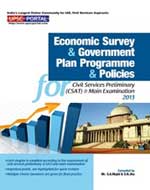
Contents of the Chapter:
- Introduction
- International Collaboration and Efforts
- Sustainable Development and Climate
- Financing Climage Change
- Change in the Indian Context
- Challenges and Outlook
Introduction
The year 2012 may arguably be considered a high water mark in
the field of environment and sustainable development initiatives. The global
community met at the UN Conference on Sustainable Development that took place in
Rio in June 2012, also marking the 20th anniversary of the landmark first Earth
Summit held in 1992. The Conference reviewed the progress made, identified
implementation gaps, and assessed new and emerging challenges, which resulted in
a political outcome called the 'The Future We Want'. In India, the Twelfth Five
Year Plan was launched with a focus on sustainable growth. This along with
sustainable development policies and programmes which are being followed
signalled to citizens at home and the world at large that India is committed to
sustainable development with equal emphasis on its three dimensions - social,
economic, and environmental. A global comparative opinion survey shows that
people in India and indeed all countries, have a marked and rising concern about
sustainable development and climate change. However, the challenges are also
formidable, especially in the context of finding the matching resources of the
required magnitude given the economic conditions. Climate science has rightly
taken up an important position in the public debate. Even as the science of
climate change grapples with uncertanities the world is witnessing more extreme
events. The urgency for action is felt more than ever before. In contrast,
though the Doha Gateway on climate change agreed upon in December 2012 ensured
that there is continuation of a multilateral and rule-based regime to reduce
emissions, the emission pledges on the table by the developed country Parties
lacked ambition. Now the Fifth Assessment Report of the Inter-governmental Panel
on Climate Change (IPCC) is in the final stages of completion. With rising
extreme events, and rising citizen demand, the world has little option but to
listen to the voice of evolving science and respond adequately with strategies
and policy rooted in the principles of multilateralism with equitable and fair
burden sharing.
The world population crossed the 7 billion mark but with
continued decline in population growth rates. Urbanization continues to grow
with more demand for resources. A United Nations Environment Programme (UNEP)
study, 'Keeping Track of Our Changing Environment: From Rio to Rio + 20 (1992-
2012)', tells the story of where the world collectively stands today on the
sustainability and environment front. According to this study, both global gross
domestic product (GDP) and the human development index (HDI increased by 2.5 per
cent per year) continue to increase but variation and inequalities between
regions still exist. The study also points to the growing pressure on
agriculture, water, fisheries, and land resources. Pressure on natural resources
reflected in per capita global use of natural resource materials has increased
around 27 per cent between 1992 and 2005 though there has been a decline in
emissions and energy and material use per unit of output, indicating improvement
in efficiency levels. At the same time global greenhouse gas (GHG) emissions
have continuously been rising. GHG emissions measured in million metric tons of
CO2 equivalent (MtCO2e) from 1990 to 2005 register an increase of 25.9 per cent
(World Resources Institute).
Twelfth Five Year Plan Approaches for Sustainable Development and Lower
Carbon Strategies
The Twelfth Plan strategy suggests that there are significant
'co-benefits' for climate action with inclusive and sustainable growth. India as
a large responsible player with very low income has also to ensure that these
efforts are matched by equitable and fair burden sharing among countries, taking
into account the historical responsibilities for emissions. These issues are
being discussed in the UNFCCC.
India's approach to a lower-carbon growth strategy explicitly
recognizes that policies have to be inclusive and differentiated across sectors
according to national priorities, so as to lower the transaction costs of
implementing the policy, and conform with a nationally fair burden-sharing
mechanism. An Expert Group on Low Carbon Strategies appointed by the Planning
Commission has outlined the lower carbon strategies for major potential carbon
mitigation sectors:
(i) Power : On the supply side, adopt
super-critical technologies in coal-based thermal power plants; use gas in
combined heat and power systems; invest in renewable technologies; and develop
hydropower in a sustainable manner. On the demand side, accelerate adoption of
super-efficient electrical appliances through market and regulatory mechanisms;
enhance efficiency of agricultural pump sets and industrial equipment with
better technology; modernize transmission and distribution to bring technical
and commercial losses down to world average levels; universalize access to
electricity; and accelerate power-sector reforms.
(ii) Transport : Increase the share of rail in
overall freight transport; improve the efficiency of rail freight transport;
make it price competitive by bringing down the levels of cross-subsidization
between freight and passenger transport; complete dedicated rail corridor;
improve share and efficiency of public transport system; and improve fuel
efficiency of vehicles through both market-based and regulatory mechanisms.
(iii) Industry : Greenfield plants in the iron
and steel and cement sectors adopt best available technology; existing plants,
particularly small and medium ones, modernize and adopt green technology at an
accelerated pace, with transparent financing mechanisms.
(iv) Buildings : Evolve and institutionalize green building
codes at all levels of government.
(v) Forestry : 'Green India Mission' to
regenerate at least 4 million ha of degraded forest; increase density of forest
cover on 2 million ha of moderately dense forest; and overall increase the
density of forest and tree cover on 10 million ha of forest, waste, and
community lands.
Dear
Candidate, This Material is from Economic Survey & Government Plan Programme and
Policies. For Details